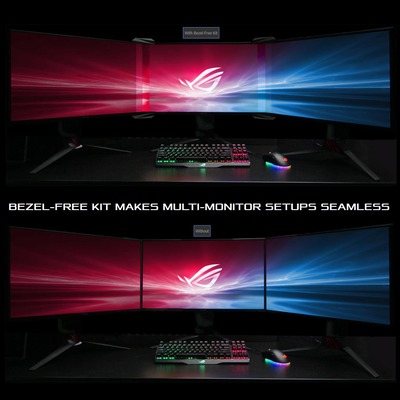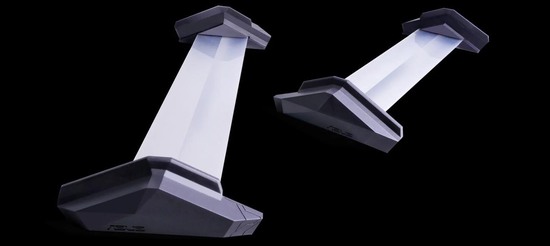Il CES '2018 di Las Vegas ha ormai raggiunto le battute finali, ed ASUS mostra un nuovo accessorio dedicato esclusivamente ai monitor ROG Swift PG258Q e Strix XG258Q, che potrebbe risolvere il "fastidio" derivante dall'utilizzo di setup multi-monitor.
Le cornici laterali dei monitor, per quanto sottili, sono da sempre il nemico di tali setup, e di recente non hanno fatto altro che promuovere la diffusione dei monitor con formato 21:9 ed addirittura - di recente - anche 32:9 (Vedi ad esempio il Samsung svela il CHG90 49" curvo con risoluzione 3840*1080p), seppur questi non possano eguagliare i classici 16:9 top di gamma per caratteristiche tecniche.
Il kit ROG Bezel-free potrebbe rappresentare la risoluzione di tutti questi mali.
All'atto pratico si tratta di alcune lenti, prodotte in PMMA (Un tipo di termoplastica trasparente più resistente del vetro che lascia passare il 90% della luce prodotta dai monitor), da posizionare direttamente sulle cornici.
Queste lenti, progettate per funzionare con un angolazione tra i monitor di 130°, non fanno altro che generare la porzione d'immagine che viene in realtà occupata dalle cornici, tramite la tecnica di rifrazione ed offuscazione ottica.
L'effetto generato, stando ai video di hands-on, sembra piuttosto apprezzabile per quanto l'installazione del kit sia semplice, di certo è meglio che vedere le cornici, e capace di offrire una maggiore immersione.
Staremo a vedere se ASUS ha intenzione di commercializzare realmente tale soluzione. Attualmente si tratta più che altro un prototipo.
BEZEL-FREE KIT MAKES MULTI-MONITOR SETUPS SEAMLESS
Multi-monitor surround setups provide unparalleled panoramas that extend well into your periphery. They’re perfect for first-person sims and shooters, but there’s a unsightly catch: bezels block the view where adjacent screens meet, interrupting your sense of immersion. At CES 2018, we’re demonstrating a new concept that hides bezels behind optical camouflage to create a more seamless picture.
Seeing is believing
We developed the Bezel-Free Kit in conjunction with one of our backlight providers, which specialize in optical materials. The concept is simple. Thin lenses are placed along the seams where screens meet; they contain optical micro-structures that refract light, bending it inward to hide the bezels underneath. Click the buttons under the image above to see the effect in action.
With Bezel-Free KitWithout
The lenses are made from PMMA, a type of transparent thermoplastic that’s much more durable than glass. This material lets 90% of the light from the monitors shine through, making the picture under the lenses slight dimmer than the rest of the screens but less distracting than the opaque seams created when two bezels are pushed up against each other. Reducing the dimming requires glass lenses that are too fragile to be practical for mass production.
Tailoring for individual models makes installation easy. Custom clips hold the monitors together at the top and bottom of each seam, which helps align them at the correct angle. The lens sits between them, reducing the kit to just three parts per seam.
The kit’s optical obfuscation is designed to work at a specific angle. We selected 130° because it offered the best balance of comfort and immersion in internal testing. Proper fit and alignment are extremely important, so the lenses and associated mounting hardware are made for specific monitors. The version being shown at CES fits the ROG Swift PG258Q and Strix XG258Q and will be demoed with the PG258Q. However, the concept can be adapted to work with other displays.
Get a glimpse at CES
CES 2018 allows us to put the bezel-free concept in front of a wide audience to gauge interest. You can see it in action at the ROG showcase suite in Las Vegas, NV, from Jan 9-12. We’re curious to know what you think, so be sure to provide your feedback in the ROG forums.
Maggiori informazioni sono disponibili sul sito ufficiale del produttore, a questa pagina.
Di seguito "l'hands-on" realizzato dai colleghi di The Verge, presenti al CES di Las Vegas:


